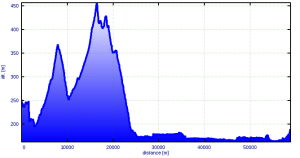Today, I went for my longest trip so far this season, which was about 75 km. Once more, I was with a group of people from TriTeam Chaos. The track itself was already well-known to me, so there’s nothing interesting to report, except maybe for the fact that my bike computer is now working again and it even shows my cadence.
Once more, I’m asking you to think about supporting my little fundraising project. I’d also be very happy if asked anybody you know who might support this. Some companies also have so-called matching gifts programs which double the employees’ donations to charities :-)
The usual numbers:
| Total distance | 75.2 km |
|---|---|
| Average speed | 26.0 km/h |
| Maximum speed | 51.8 km/h |
| Total climb | 307 m |
| Average heart rate | 152 bpm |
| Maximum heart rate | 202 bpm |
| Average cadence | 61 rpm |
| Time active | 02:53:19 |
| Time resting | 00:16:57 |
| Energy consumed | 1604 kcal |
Note: The climb was measured using a non-calibrated barometric altimeter; the amount of energy consumed was calculated from the measured heart rate and physiological parameters.
The GPX file recorded during this trip can be found here.
Read more about the “Tracking for Freedom” project here. All blog posts about the project are tagged Tracking for Freedom.


